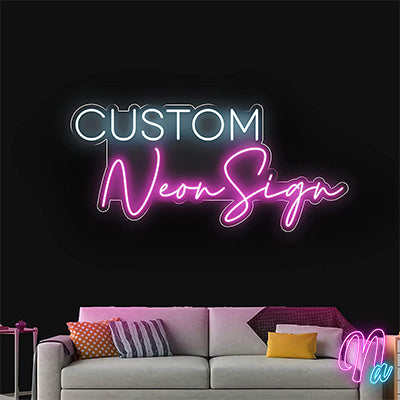LED Neon Lights vs. Neon Tubes: Which One is More Energy Efficient?
If you're in the market for stylish lighting options for your home or business, you may have come across neon lights and LED neon lights. Neon lights, made from glass tubes filled with gas and powered by high-voltage electrical currents, have been a popular choice for signage and decoration since the early 20th century. However, in recent years, LED neon lights have gained popularity due to their energy efficiency and environmental friendliness.
In this article, we will explore some of the key questions and concerns related to neon lights and LED lights. Specifically, we will examine the energy efficiency of these two types of lighting, as well as their environmental impact, power consumption, and other factors that may affect their performance and usefulness.
Are neon lights eco-friendly?
One of the main concerns about neon lights is their environmental impact. Neon lights are made from glass tubes filled with gas and a small amount of mercury, which can be harmful to human health and the environment if not properly disposed of. Additionally, the production and transportation of neon lights can have a significant carbon footprint, especially if they are imported from overseas.
However, it is worth noting that neon lights can be recycled, and some companies are now using more sustainable materials and production methods to reduce their environmental impact. Furthermore, neon lights can have a long lifespan if maintained properly, which can help to reduce waste and the need for frequent replacements.
What are the disadvantages of neon lights?
While neon lights have many advantages, they also have some disadvantages that should be considered when considering their use. One of the main drawbacks of neon lights is their fragility. Neon lights are made from glass tubes that can break easily, which can be dangerous and expensive to replace.
Another potential issue with neon lights is their high voltage and energy consumption. Neon lights require a high voltage to operate, which can be a safety hazard if not properly installed and maintained. Additionally, neon lights are not very energy efficient compared to other types of lighting, such as LED lights, which can result in higher electricity bills and a greater environmental impact.
Neon vs LED power consumption
The power consumption of neon lights and LED lights is an important factor to consider when choosing between these two types of lighting. LED lights are known for their energy efficiency, with some estimates suggesting that they can use up to 80% less energy than traditional incandescent bulbs. LED lights also have a long lifespan, which can help to reduce the need for frequent replacements and further reduce energy consumption.
On the other hand, neon lights are not as energy efficient as LED lights and can use a lot of electricity, especially if they are left on for long periods of time. Additionally, neon lights require a high voltage to operate, which can further increase their energy consumption and cost.
Do neon lights use a lot of energy?
As mentioned earlier, neon lights can use a lot of energy, especially if they are used frequently or left on for long periods of time. The exact amount of energy used by a neon light will depend on a variety of factors, including its size, voltage, and the length of time it is used.
However, it is worth noting that some companies are now using more energy-efficient production methods and materials to reduce the energy consumption of neon lights. Additionally, there are ways to optimize the use of neon lights, such as turning them off when not in use or using them in conjunction with other types of lighting to reduce overall energy consumption.
Disadvantages of Neon Lights
Despite their impressive glow and vintage appeal, neon lights have some drawbacks. One of the biggest disadvantages of neon lights is their fragility. Neon lights are made of glass tubes, which can easily break if they are mishandled or hit. Additionally, neon lights require a high-voltage transformer to operate, which can be dangerous if not installed properly. Finally, neon lights are not as versatile as LED lights when it comes to color options and customization.
Neon vs LED Power Consumption
Now that we've explored the benefits and drawbacks of both neon and LED lighting, let's take a closer look at their power consumption. In general, LED lights use less energy than neon lights. LED lights are highly efficient, using up to 80% less energy than traditional light bulbs. On the other hand, neon lights require a high voltage to operate, which can result in higher energy consumption.
Neon Light Wattage
The amount of power a neon light uses varies depending on its size and wattage. Typically, a neon light will use around 3-4 watts per foot of tubing. For example, a 6-foot neon sign will use around 18-24 watts of power. While this may not seem like a lot, it can add up over time and result in higher energy bills.
Eco-Friendly Lighting
With concerns about climate change and energy conservation on the rise, many consumers are seeking out eco-friendly lighting options. When it comes to neon vs LED lighting, LED lights are generally considered to be the eco-friendlier choice. LED lights use less energy and last longer than neon lights, which means they have a smaller carbon footprint overall. Additionally, LED lights are free of hazardous materials such as mercury, which can be found in some types of fluorescent lighting.
In conclusion, both neon and LED lighting have their benefits and drawbacks. Neon lights offer a classic and nostalgic feel, but they can be fragile, require more energy to operate, and have limited color options. On the other hand, LED lights are highly efficient, customizable, and offer a wide range of colors. When it comes to power consumption, LED lights are the clear winner. They use less energy and have a smaller carbon footprint than neon lights. Ultimately, the choice between neon and LED lighting comes down to personal preference and the intended use of the lights. Whether you're looking for a vintage neon sign or a modern LED light fixture, there are plenty of options available to suit your needs.
If you want to learn more about the differences between LED lights vs traditional neon lights, please read Glow Up: The Battle Between LED Neon Signs And Glass Neon Signs











